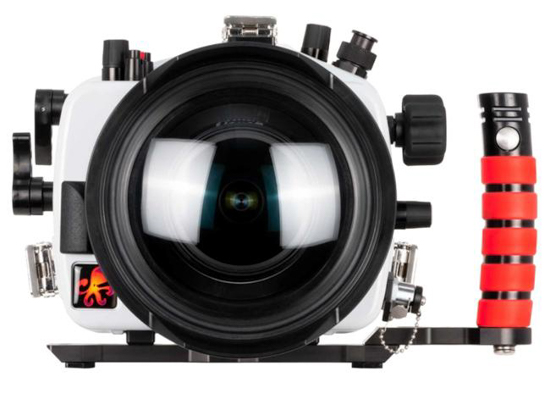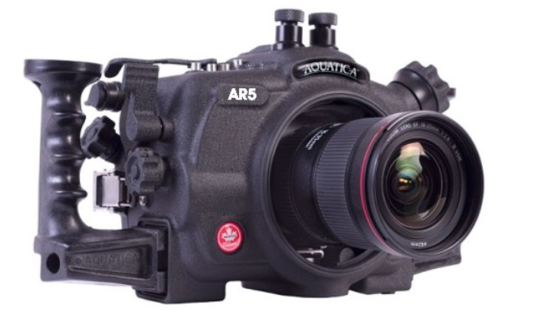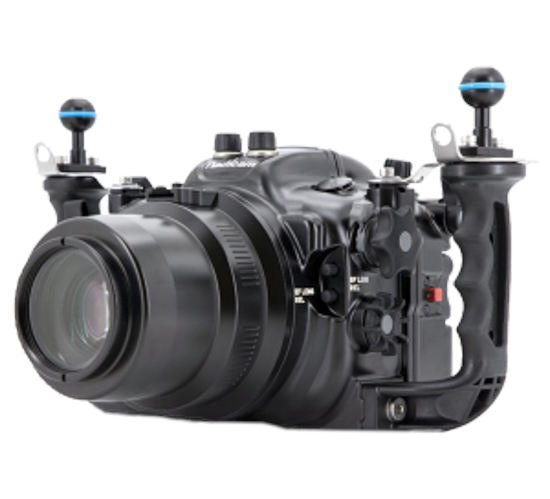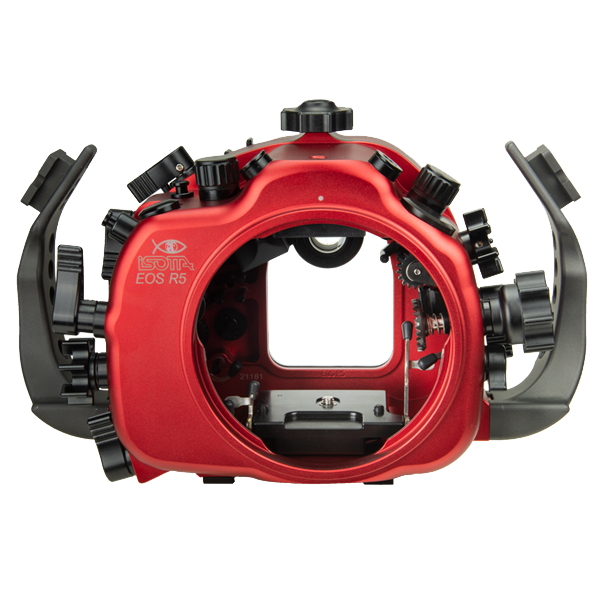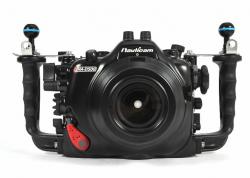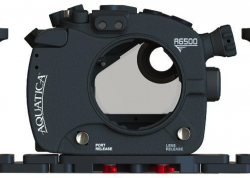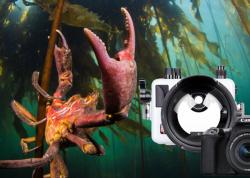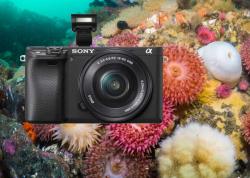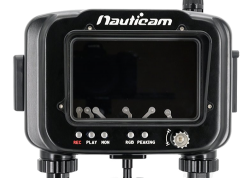Canon EOS R5 Review
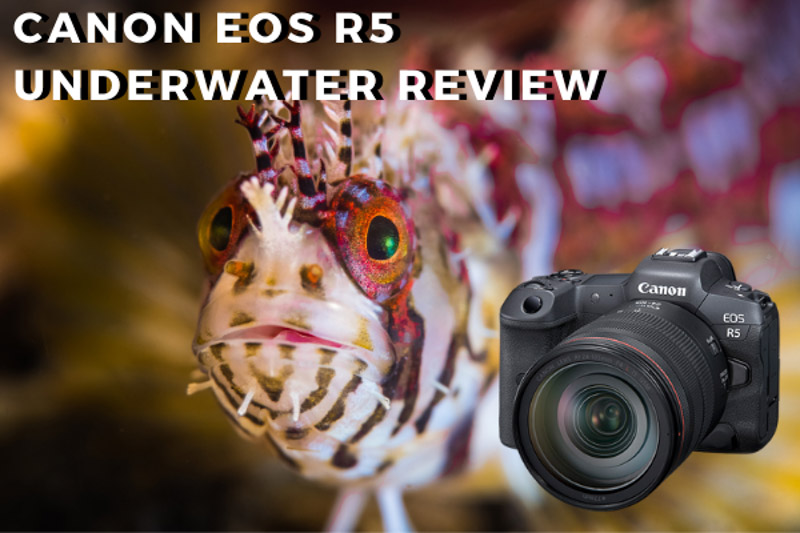
The Canon EOS R5 is no doubt the most popular camera to hit the market in the last decade. It's also a testament to the amazing technological progress made in the mirrorless camera field in recent years. With the ability to shoot 8K RAW video, 4K video at 120 fps, 45 megapixel still images, and image stabilization capable of 8 stops of recovery, the R5 is the elusive dream camera....at least on paper.
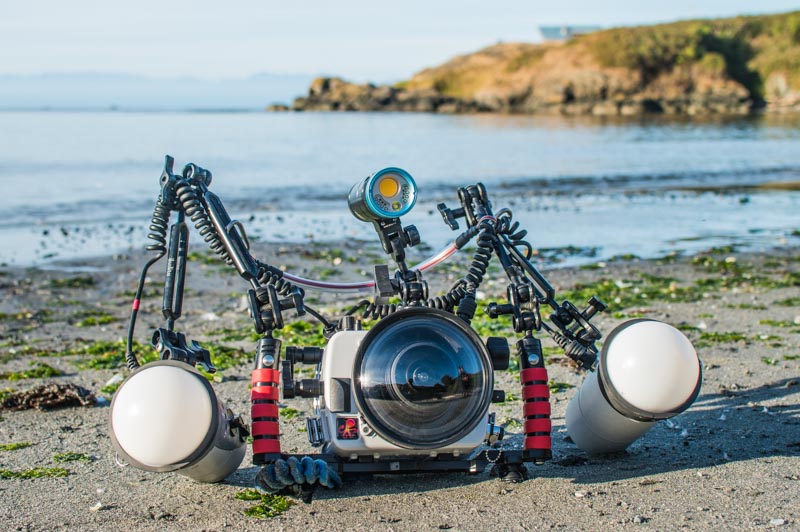
It's our job at the Underwater Photography Guide to separate fact from fiction. So we made sure to be some of the first divers in the world to take the EOS R5 underwater. With a little help from Ikelite and Glazer's Camera in Seattle, we were able to secure one of the first R5 housings and R5 cameras. Braving wind, wildfire smoke, currents, and surf, we dove into the cold, plentiful waters of the Pacific Northwest. Our results speak for themselves - after a week of diving with this amazing (surprisingly compact) beast of a machine, we think the Canon EOS R5 is the best camera on the market for underwater photographers and one of the top cameras on the market for underwater videographers - depending on their specific use case. Although there are some overheating issues when shooting video at high frame rates (e.g., 4K @ 120fps) and high resolutions (e.g., 8K), we think that it has been too much of a focus point in the press. This is due to Canon's poor marketing strategy of marketing the R5 as a video-oriented camera. If you are looking for the top full-frame stills or hybrid camera on the market, the Canon EOS R5 is currently the most obvious choice for underwater photography with the best IBIS on the market, eye autofocus tracking that (sometimes) works on fish, 45 megapixels of gorgeous resolution, 4K video @60p, and quick burst shooting speeds of up to 20 frames per second.
With the release of Canon's latest interation of the R5, namesly the R5 Mark II, we expect this new camera to firmly build on the popularoty of it's predecessor. The Canon R5 is still a very popular camera, but the R5 Mk ii builds on that solid foundation, showing some marked improvements in autofocus, improved 8k video and professional grade c-log 2 recording.
Status: Shipping Now (with some delays)
U.S. MSRP Canon EOS R5: $3,899
Jump to Section
EOS R5 vs EOS R6 vs EOS R | Specifications | Key Features
EOS R5 for Underwater Photo and Video | Who Should Buy? | Underwater Lenses
Underwater Housings | Conclusions
Purchase a Canon EOS R5 underwater housing at Bluewater Photo:
Nauticam Canon EOS R5 Underwater Housing
Ikelite Canon EOS R5 Underwater Housing
Sea & Sea Canon EOS R5 Underwater Housing
Aquatica Canon EOS R5 Underwater Housing
Isotta Canon EOS R5 Underwater Housing
Marelux Canon EOS R5 Underwater Housing
More Canon EOS R5 Content:
Top Canon EOS R5 Underwater Settings
Does the Canon EOS R5 Overheat Underwater?
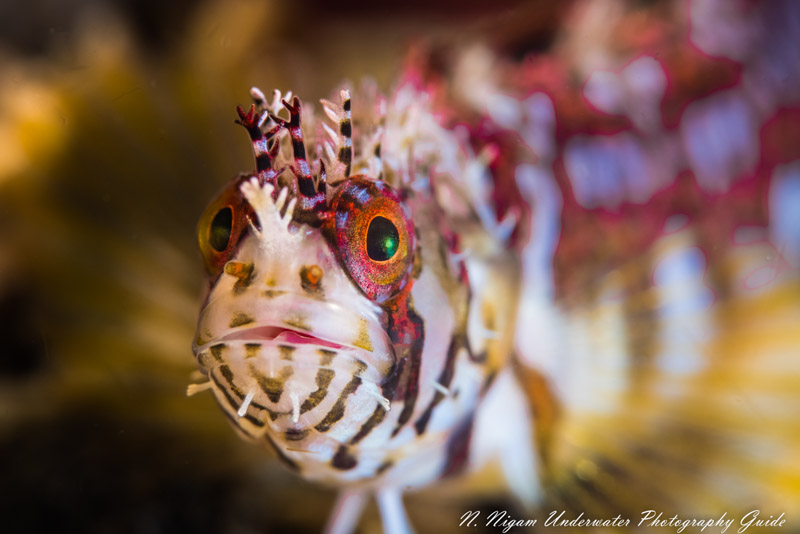
Canon EOS R5 Compared with Canon EOS R
The Canon EOS R5 addresses many of the concerns from the original Canon EOS R release and brings the camera line to levels far beyond its competition.
For underwater photography, Canon was lagging behind Sony and Nikon because of a lack of in-body image-stabilization. The Canon EOS R5 is Canon's first camera with IBIS, capable of 7-8 stops of correction when combined with a stabilized lens. Fortunately, Canon has a large selection of stabilized lenses from both its RF and EF line up which can be used with an adapter. On paper and in practice, Canon's IBIS performs better than Sony and Nikon.
The R5 is equipped with a new 45 megapixel CMOS sensor. This is a much higher resolution than the original 30 MP sensor on the EOS R - addressing concerns that the EOS R was not a high enough resolution for professionals. Furthermore, the EOS R5 has the capability of shooting 12fps in burst modes (20 fps electronic shutter), up from the 8fps on the EOS R. Did we mention dual card slots?! That's right, the EOS R5 is equipped with one Cfexpress and one UHS-II SD card slot, thus solving the concern of not having redundant media cards to back up your content on the go. Unfortunately, video shooters will find a loss of redundancy with certain resolutions, frame rates, and file formats due to the fact that one card is an SD card.
In many ways, Canon overcompensated for the EOS R's lackluster video performance with the R5. For underwater videography, the original EOS R fell short of its competitors by offering cropped 4K video, rather than 4K using the full width of the sensor. The EOS R5 goes above-and-beyond at addressing these concerns. The EOS R5 is capable of 8K RAW internal video recording using the full width of the sensor that can also be downsampled into 4K. It also features 4K oversampled, uncropped video up to 120 frames per second. However, because there are only slight body modifications from the original EOS R5 - there are some issues with overheating. Read more about the underwater overheating tests that were done at Bluewater Photo.
The Canon EOS R5 will need a new housing if you intend to upgrade from an EOS R housing.
Canon EOS R5 Compared with Canon EOS R6
The Canon EOS R5 and Canon EOS R6 are close siblings in many respects. The main differences between the two cameras are resolution, video recording capability, and, of course, price. While the R5 has a 45 MP CMOS sensor, the R6 is equipped with a 20.1 MP sensor - likely the same sensor as the Canon 1DX Mark III. Although this might be too low of a resolution for some users (especially macro shooters), the 20.1 MP sensor promises amazing low light performance with less noise at higher ISOs. This is likely due to the fact that each pixel on the R6 is larger than the R5. It is also important to note that the camera's closest competitors, the Nikon Z6, Sony A7 III, and the original Canon EOS R, all have higher resolution sensors. When it comes to underwater video, the EOS R6 can shoot 4K at 60 fps with is well beyond the capability of its competitors, but certainly not as capable as the R5. The R6 can shoot 4K @ 60fps for up to 35 minutes due to overheating concerns. The EOS R6 is retailing for $2,499 compared to the R5 at $3,899.
Other than those few distinctions, the cameras are very similar. Both cameras are capable of shooting at amazing burst speeds - 12fps with the mechanical shutter and 20 fps with the electronic shutter. Both cameras are equipped with similar autofocus systems, capable of covering 100% of the field of view! The autofocus tracking systems in both cameras is phenomenal and capable of detecting fish faces and eyes about 20-40% of the time in macro modes.
Finally, when it comes to build - it appears that both cameras are very similar, but they differ in size by a few millimeters. This means that they will require separate housings.
Canon EOS R5 Specifications
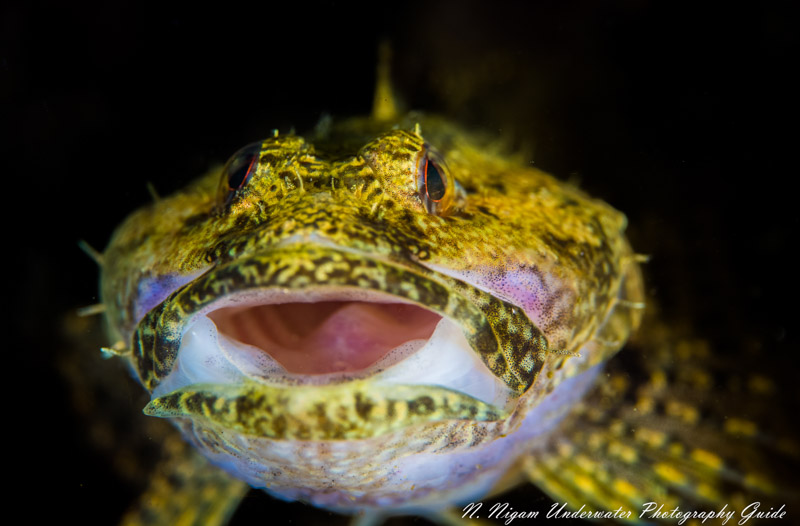
Key Canon EOS R5 Specs
- New 45 Megapixel Full-Frame CMOS Sensor
- DIGIC X Image Processor (same as the 1DX Mark III)
- Canon's first 5 axis In-Body Image-Stabilization (IBIS) which works in conjunction with optical IS RF and EF lenses. Up to 8 stops of correction
- Canon RF Mount (compatible with EF mount lenses with the EF-EOS R mount adapter)
- Improved Dual Pixel II Autofocus with 1053 zones
- Low light AF capability down to EV -6 and up to 20 (f/1.2 lens, ISO 100)
- 100% of the sensor has AF coverage!
- Animal eye AF detection (for birds, cats, and dogs). It works about 20-40% of the time for fish eye detection in macro.
- 12fps burst shooting with mechanical shutter
- 180 shot RAW buffer @ 12fps
- 20 fps burst shooting with silent (electronic shutter)
- ISO 100-51200
- Mechanical shutter sync speed: 1/200 sec
- Dual card slots - 1x CFexpress and 1x SD UHS-II
- 8K video @ 30p, 10- bit 4:2:2 - using the full width of the sensor!
- Internal RAW and C-Log recording
- 4K oversampled video up to 120p, 10-bit 4:2:2
- 22 customizable functions
- 5.76 million dot OLED electronic viewfinder
- 490 shot battery life w/ LCD, 320 shot battery life w/ EVF (enough for about 3 dives in photo mode)
- Size: 5.45 X 3.84 X 3.46 in
- Weight: 1.63 lbs/738g (body w/ battery, CFexpress card)
Canon EOS R5 Key Features
Body, Build, and Ergonomics
We love Canon for their ergonomic designs, and Canon kept up the standard with the EOS R5. The build quality and size of the body is similar of the original EOS R. Grip and button placement are very similar to Canon DSLRs, so it will be easy for any Canon user to migrate to the R5. Button placement on the R5 is a little more streamlined than on the original EOS R. The construction is solid and the body is weather sealed. The body felt a little plastic-y to us, but if that's how Canon is saving costs, we don't mind. It doesn't affect the integrity of the camera.
Updates to the R5's controls do have implications for underwater photography. Canon removed the touch bar that was so despised in the original EOS R and replaced it with a joystick. For topside photographers, this means it's very easy to navigate the menus, select AF points, and control the camera with just the joystick. However, underwater photographers may be a bit more limited in their control of the camera if their housing doesn't support the joystick. For underwater photography, the R5 is all about the dials. In fact, the camera has three - including a dial on the back panel instead of the D-Pad. At first, we found it a little frustrating to control the camera functions using dials during our underwater tests. But after muscle memory kicked-in, it actually became a lot easier than pressing buttons on a d-pad. If you intend to shoot this camera underwater, be prepared to turn more dials and use fewer buttons.
Mirrorless cameras need an electronic viewfinder (EVF) instead of the traditional optical viewfinder in DSLRs. EVFs are useful because you can review your images and settings changes right in your viewfinder! The 5.76 million dot electronic viewfinder (EVF) on the Canon EOS R5 has a similar resolution to its nearest competitors, the Sony A7R IV and the Panasonic S1H. We found it very nice to use and operate. EVFs offer the added benefit of being able to review your images and change settings directly in the viewfinder. You won't have to take your eye off the camera for the whole dive!
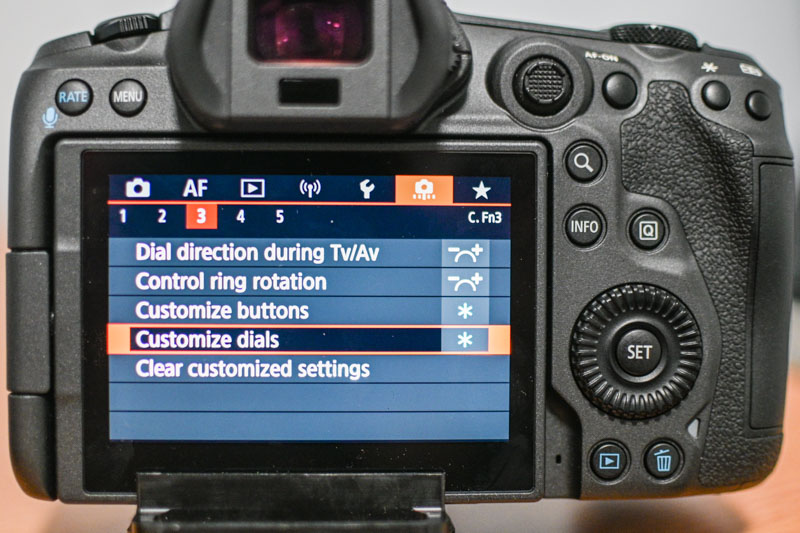
Battery Life
On paper, the EOS R5 is rated for 490 shots of battery life with the LCD and 320 shots with the EVF. During our dives, where we shot hybrid photos and videos using the only the LCD, we found that one battery was good for about 200-300 photos and 5-6 minutes of video. This was the equivalent of about 3 dives for one battery. Video shooters can expect one to two dives on a single battery depending on frame rates, resolution, and file types. Overall, the battery life could be better, but given the insane amounts of data this camera needs to process, we were happy with it.
Image Quality
With a 45MP CMOS sensor, the EOS R5 is a high resolution camera by any standard. Although many new cameras are coming to the market with this sort of resolution - 45 megapixels is still groundbreaking - especially for a Canon mirrorless cameras. The original EOS R offered 30 megapixels of resolution. So any photographer who was waiting for Canon to come out with their professional grade mirrorless camera - this is it! Macro photographers who are looking to crop their images and bring out even more miniscule details should consider the R5 over the R6 or R. Any photographer will benefit from the ability to create large, high resolution prints.
When it comes to resolution, the EOS R5 is on par with the Sony A7R III (42MP) and the Nikon Z7 (45.7MP) - both popular high resolution full-frame cameras with professional photographers. After diving with the R5, we felt that 45 megapixels is exactly the right choice for this camera. 45 MP is just enough resolution to capture detailed pigments on skin, cirri on fish, and parasites on gills. Although there is slightly more noise in each image than a lower resolution image from the R6, it's not very noticeable. The noise is very easy to remove in post-processing because it's fine-grained noise. The R5 also avoids some of the problems that came up with the 60 MP Sony A7R IV - which includes an increase in motion blur due to the fact that there are more megapixels crammed into the same area.
The dynamic range on the Canon EOS R5 is similar to its competitors in the market like the A7R IV and Z7 - which is excellent. We did notice during some of our sunball shots that there was a little less details in the whites of the sunballs and it was a little more difficult to expose sun rays. However, it is difficult to determine if this experience is measurable or anecdotal.
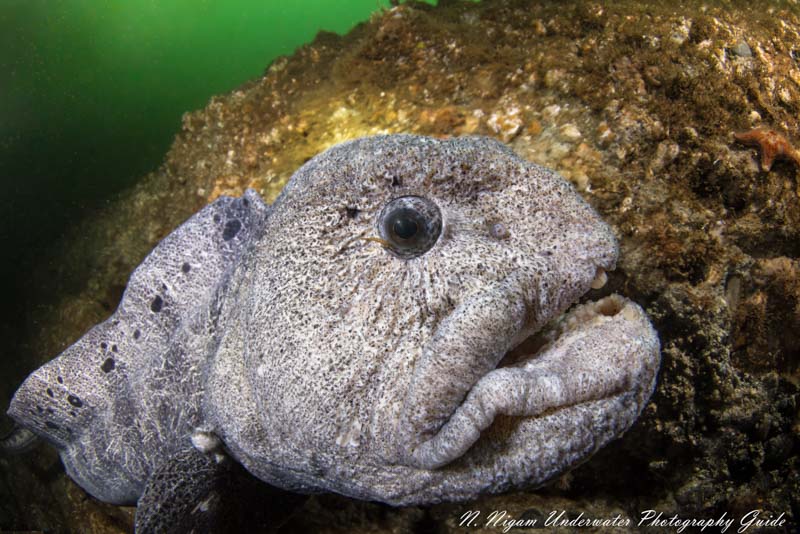
Unique Autofocus Capability
With all of the hype surrounding the R5's video specs, the camera's spectacular autofocusing ability was definitely overlooked. In fact, this might be one of the most exciting aspects of the camera for underwater photography. The R5 is gifted with Canon's dual pixel II autofocus system with 100% coverage of the sensor! That's a Canon first. This means that no matter what scene you are shooting, you will be able to select an autofocus point anywhere in the scene - yielding total creative control of the image.
Moreover, the autofocus tracking capability, which was already great in the EOS R, has been significantly improved in the R5. Along with better eye AF tracking, the R5 has been introduced with animal eye AF tracking capable of tracking birds, cats, an dogs. After testing this feature extensively, we've determined that Canon's eye autofocus tracking will work on fish about 20-40% of the time with macro lenses. It has a little more difficulty for wide angle shooting as fish generally appear smaller in the sensor. So far, this is the most reliable eye AF tracking for fish on the market. Even if the camera misses the fish's eye, you can still select your autofocus point in tracking mode. This adds a second layer of security in the autofocus tracking mode.
When it comes to autofocus speed, the Canon EOS R5 is much quicker than Nikon's current mirrorless AF systems but slightly slower than Sony's. We still think that Sony has a quicker AF tracking system. In other autofocus modes, it is difficult to see much of a difference. For AF tracking, the Sony A7R IV is still the best camera on the market.
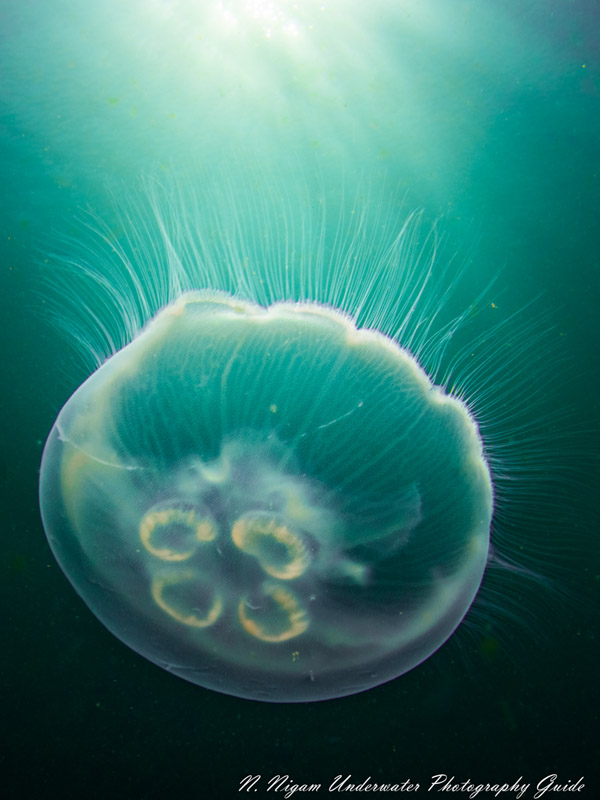
In-Body Image-Stabilization
In-Body Image-Stabilization (IBIS) is a system that has become ubiquitous in mirrorless cameras. It is used to stabilize an image or video by allowing the sensor to move in order to compensate for camera shake that could cause motion blur. Canon's marketing material claims the R5 will be able to recover 7-8 stops of exposure with its IBIS system. This means an image that is 7-8 stops darker can be exposed properly without a tripod than what is capable when not using IBIS.
The Canon EOS R5 is Canon's first camera with 5-axis in-body image-stabilization. After putting it through the wringer, we think the R5 actually has the best IBIS system on the full-frame market - both on paper and practice. For underwater photography, we were able to shoot at very low shutter speeds (e.g., 1/13th of a second or lower) and still capture crisp, beautiful details. We even found ourselves dropping shutter speeds beyond recommended levels accidentally while metering our backgrounds. This sort of exposure recovery was especially useful in the cold, dark water of the pacific northwest - albeit, with subjects that weren't moving very quickly! For underwater video IBIS, we were able to capture very stable hand-held video, even @ 100 mm. It also appears that Canon has fixed the wobble that initially caused complaints after the R5's release.
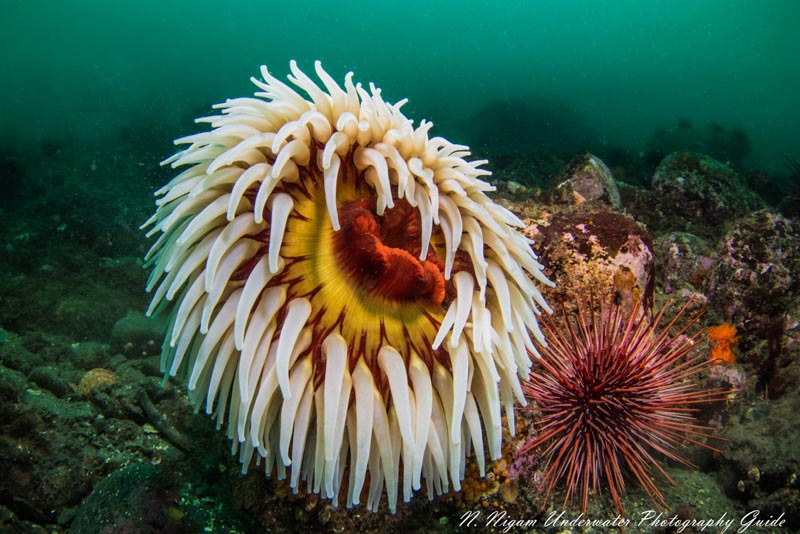
Improved Video
The Canon EOS R5's video specs have created quite the stir after the R5's announcement. The crop factor on Canon's original EOS R is no longer an issue. The camera is capable of 8K internal RAW video recording @ 30 fps using the full width of the sensor. We shot some 8K video underwater. It's beautiful resolution, but without an 8K screen it's difficult to tell the difference from 4K. However, it's nice to have the capability of cropping down 8K video, especially for framing macro subjects. But we think this feature will be used sparingly. After all, 20 minutes of 8K RAW recording yields about 300 GB of data.
When it comes to 4K video, the camera is capable of recording 4K @ 120fps. This is a huge deal for underwater videographers who are looking to slow down and stabilize their clips in shaky underwater environments. Combined with 5 axis IBIS, there's no beating the EOS R5 for stable, high resolution underwater video.
The EOS R5 can record both RAW and C-Log video internally, so the user can choose just how much video editing capability they desire with the files. We like C-Log one for recovering as much dynamic range as possible, but we're looking forward to the rumored addition of C-Log 3 in a future firmware update.
Overheating Concerns
.
While Canon used 8K RAW internal recording as a cornerstone of its marketing for the camera, there has been some recent backlash about the limited recording times the camera is capable of due to overheating. Certainly the R5's specs were an ambitious project and the technology to cool down the camera is not quite at the level of ambition. While Canon has published the full spec list of recording times at different frame rates and resolutions, the dedicated staff at Bluewater Photo have done some underwater tests of the camera's overheating limitations.
The final verdict?
1. For underwater photo shooters, there's nothing to worry about - the camera won't over heat.
2. For most underwater hybrid shooters the camera likely won't overheat. Especially if you are shooting less than 20 minutes of 8K video (i.e., 300 gb of data) during a dive.
3. Dedicated video shooters that want to film 8K @ 30p or 4K @ 120fps will be limited to about 20 minutes of shooting during a dive. The recovery time at these frame rates and resolutions is about 20-30 minutes (while the camera is off), so it is likely the dive will be over before a videographer would be able to shoot any significant length of additional video.
Canon EOS R5 for Underwater Photography
The Canon EOS R5 is clearly be one of the best tools on the market for underwater photography. A higher resolution, 45 megapixel full-frame sensor places the camera in the same niche as the Nikon Z7 and Sony A7R III/A7R IV. We feel that the R5 performs better than all three of those cameras. The image quality and dynamic range is on par with the Nikon Z7 and Sony A7R III. If you want the highest resolution full-frame sensor in the world, the Sony A7R IV measures higher than the R5. However, it's important to consider the kinds of underwater photography you will be doing if you are thinking about the A7R IV. We think the additional megapixels are a benefit for macro shooters who need more resolution in their crops. For wide angle shooters, the R5 could be a better option as 45 megapixel sensors have less issues with noise and motion blur.
When it comes to lens options, there aren't many RF mount option out there for underwater photography, but the EF mount options with the EF-EOS R adapter work seamlessly. There isn't much of a noticeable difference in the autofocus using an EF adapted lens as compared to the native RF lenses. Canon offers some of the best glass for underwater photography on the market with their EF lenses, arguably better than Sony and on-par with Nikon. We think that pairing the EOS R5 with the Canon 8-15mm fisheye and the Canon 100mm macro make this camera a macro and wide angle powerhouse.
The R5's autofocus system is the only system on the market that offers 100% coverage of the sensor - which means the artistic freedom to place AF points meets no boundaries. We found that the autofocus was quicker than Nikon's current mirrorless system and just slightly slower than the AF system on the Sony A7R IV. That being said, in AF modes other than AF tracking the AF speed is quick, snappy, and on par the best Sony has to offer. One unique aspect of the R5's autofocus system is the fact that it can track fish eyes about 20-40% of the time with a macro lens. This is the first camera on the market that has been able to produce reliable results for fish eye AF tracking.
With amazing burst speeds of up to 12 fps mechanical and 20 fps electronic, the EOS R5 is an excellent camera for wide angle shooters who need to photograph quick, moving subjects. For photographers that don't need to use strobes, 20fps with the electronic shutter and 45 megapixels of resolution can result in some spectacular photographs of natures quickest phenomenon.
Finally, Canon's first rendition of IBIS is the best on the market. With 7-8 stops of recovery possible, we found that we were able to expand our photographic capability in low light situations. We were frequently able to shoot photos below 1/13th of a second and still capture crisp, beautiful images.
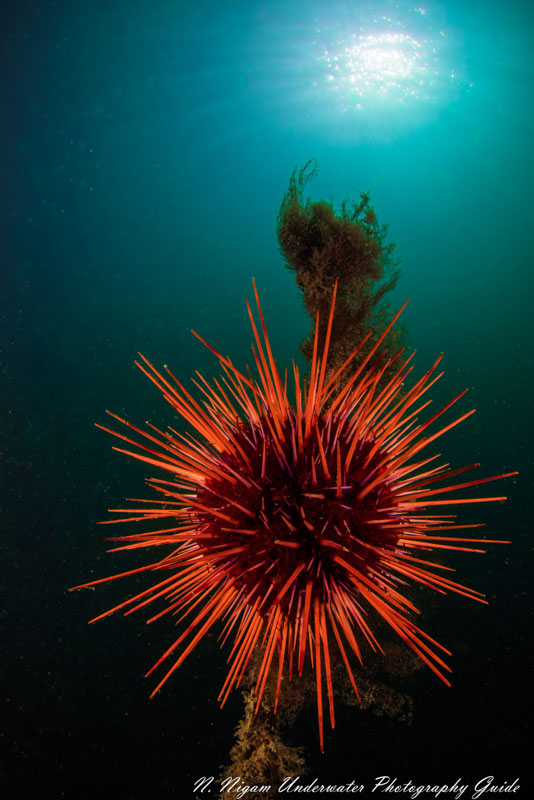
Canon EOS R5 for Underwater Video
The Canon EOS R5's underwater video capability is better than other other full-frame mirrorless cameras on the market. Although Canon overhyped the camera's 8K recording capability, the camera is a notable for underwater video for a few key reasons. The R5 can capture internal RAW files for excellent post-processing flexibility. It can shoot 4K video @ 60p without significant underwater recording limits. The In-Body Image-Stabilization system is the best on the market, making hand-held underwater video a much more attainable endeavor. And finally, the dual pixel autofocus tracking is very cinematic and excellent for keeping up with quick moving underwater subjects. As we discussed, earlier in the review, overheating issues with the camera do limit the R5 when shooting 4K @ 120 fps and 8K @ 30p. If you are a dedicated video shooter that wants to utilize these features for most of the dive, then it might be a good idea to look at the underwater cinema market.
After our dives, we felt the Canon EOS R5 is an excellent camera for capturing 4K video at 60 frames per second, which is what most casual and even dedicated video shooters need. The underwater video we captured has beautiful dynamic range, stable movement, and excellent detail. For hybrid shooters, the R5 should be a top consideration. For dedicated video shooters, perhaps it's a good idea to take a look at the Sony A7S III.
Sample Canon EOS R5 Underwater Video
Sample Canon EOS R5 Underwater 8K Video
Who Should Consider Purchasing the Canon EOS R5?
The Canon EOS R5 is one of those rare cameras that would work very well for any professional underwater photographer or videographer. There's no doubt that it is a high-end full-frame mirrorless camera for anyone who is looking for the best on the market. It features in-body image-stabilization and resolutions high enough for macro photography. It has burst shooting abilities good enough for wide angle shooters. If you are a Canon shooter looking to upgrade, the EOS R5 is definitely a worthwhile upgrade. It also offers features like IBIS and eye AF tracking that make it worth switching over from a DSLR. When compared to the Nikon Z7, the R5 has had a couple of years to catch up, and there's no doubt the R5 is the better camera. Nikon needs to do better with their autofocus and video specifications to catch up to the R5. When compared to the Sony A7R IV, we think the Canon EOS R5 is a better camera by a slight margin, mostly due to the lens options for underwater photography and video. However, if you need the absolute highest level of resolution, it could be worth taking a look at the Sony A7R IV.
To recap, underwater wide angle photographers would be hard pressed to find a better camera due to quick burst speeds, great autofocus tracking, and less issues with image quality than the Sony A7R IV. Macro photographers might want to consider the Sony A7R IV for the increased 60 MP resolution, but they should also be happy with the EOS R5. Hybrid photo and video shooters should consider the EOS R5 over any other full-frame mirrorless camera, but dedicated video shooters might want to consider the new Sony A7S III.
Recommended Canon EOS R5 Underwater Lenses
Macro
Macro lenses enable to you get close up shots of little critters.
Canon RF 100mm f/2.8L Macro IS USM: This is the best macro lens for small and shy subjects due to a larger working distance. It’s also an essential tool for supermacro photography when combined with a macro diopter. The Canon RF 100mm macro is a superior lens compared to the EF version because is has an additional magnification and can capture photos at a supermacro 1.4:1 ratio. The Canon RF 100mm is also equipped with a spherical abberation control ring.
Canon EF 100mm f/2.8L Macro IS (with EF-EOS R Adapter): This is a great macro lens for small and shy subjects due to a larger working distance. It’s also an essential tool for supermacro photography when combined with a macro diopter. We tested this lens with the Canon EOS R5 and loved how sharp the photos were and the working distance for skittish subjects.
Nauticam Super Macro Converter: The Nauticam super macro converter (SMC-1) is a wet diopter that can help capture sharp macro and super macro images. It’s the strongest, sharpest diopter on the market. If you are a super macro photographer, this diopter is best used with the Canon 100 mm f/2.8 macro.
Wide Angle Fisheye
Wide angle fisheye lenses allow for an ultra-wide field of view but result in a distorted image. The distortion is reduced underwater to the angle of refraction of light through the water.
Canon EF 8-15mm f/4L circular fisheye (with EF-EOS R Adapter): This is going to be the best choice for a full-frame fisheye lens. At 8mm, the lens vignettes over itself creating a cool, artistic, circular fisheye affect. For traditional fisheye images, just zoom into 15mm and you will capture beautiful ultra-wide angle shots without vignetting. We tested this lens with the Canon EOS R and loved its functionality and quick autofocus with autofocus tracking.
Rectilinear Wide Angle
Rectilinear wide angle lenses retain a wide field of view but do not exhibit the distortion found on fisheye lenses. They are great for large animals like sharks and reefscapes.
Canon RF 14-35mm f/4 L IS USM: This lens is our top rectilinear wide angle lens choice for underwater photographers using an EOS R style mirrorless camera. With a reduced flange distance in the RF lens mount, the corner sharpness produced by the RF 14-35mm is incredible for a rectilinear lens. That being said, be aware that this lens produces vingetting at 14 mm. Plan on using this lens as a "16-35mm" equivelant. Most underwater shooters use rectilinear wide-angle lenses for shooting subjects that don't come close enough to fill the frame with a wide fisheye lens: sharks, whales, sea lions, dolphins, etc.
Canon EF 16-35 f/2.8 III Ultra-Wide Zoom lens (with EF-EOS R Adapter): This lens is the a great choice for those who are buying their first wide-angle lens and don't have a strict budget. Most underwater shooters use rectilinear wide-angle lenses for shooting subjects that don't come close enough to fill the frame with a wide fisheye lens: sharks, whales, sea lions, dolphins, etc.
Canon EF 16-35mm f/2.8L II Wide-Angle Lens (with EF-EOS R Adapter): This has been the most popular rectilinear wide-angle lens for Canon full frame. This lens sat at the top of the selection for the last few years in terms of corner sharpness, speed, and price... although that will change as more new shooters purchase the version III.
Canon EF 11-24mm f/4L Ultra Wide-Angle Lens (with EF-EOS R Adapter): Want the widest lens you can buy? The Canon 11-24mm offers a much wider field of view than the 16mm. This perspective is great for reefscapes, massive wrecks and very wide shots where you do not want the distortion of a fisheye lens. The downside is that this lens is larger, heavier and more expensive than the other wide-angle lens choices.
Underwater Housings for the Canon EOS R5
Due to the popularity of the Canon EOS R5, we anticipate housings from all leading underwater housing manufactures. There are already some excellent housing options available from Nauticam, Ikelite, and Aquatica. We expect Isotta and Sea & Sea to announce their housing options in early 2021. Ikelite's housing is a light-weight polycarbonate option whereas all other major housing brands are anodized aluminum. Isotta housings are very compact and complete with a red finish, Nauticam housings are compatible with Nauticam's renowned optics, Aquatica's housings are some of the most rugged available, and Sea & Sea's housings are elegantly engineered with cool features like glow-in-the-dark buttons.
If you are upgrading to the Canon EOS R5 from the EOS R, you will need a new housing. The EOS R6 will likely require a separate housing as well, but this has not yet been determined for most brands.
Ikelite Canon EOS R5 Underwater Housing
The Ikelite Canon EOS R5 underwater housing is a high quality, polycarbonate model with great underwater buoyancy and ergonomics. This housing can be used with the Ikelite Canon TTL converter and Ikelite strobes for extremely fast and accurate exposures underwater.
Aquatica Canon EOS R5 Underwater Housing
The Aquatica Canon EOS R5 housing might be the most rugged housing for the R5 on the market. It is robust and made of anodized aluminum with a depth rating of 130m (425 ft). The buttons and dials are very robust and are designed with accessibility in mind.
Nauticam Canon EOS R5 Underwater Housing
The Nauticam Canon EOS R5 housing is a top aluminum housing with excellent ergonomics, HDMI Output Support for external recorders, a patented port lock system, and compatibility with professional Nauticam optics.
Isotta Canon EOS R5 Underwater Housing
The Isotta Canon EOS R5 anodized aluminum housing is complete with an artisanal red finish. We love the double oring seal, single hand locking system, and stylish but comfortable handles.
Sea & Sea Canon EOS R5 Underwater Housing
The Sea & Sea Canon EOS R5 underwater housing is a high-end, Japanese-made aluminum housing built to withstand any underwater conditions. It comes with useful features like glow-in-the-dark buttons and compatibility with Sea & Sea's TTL converters.
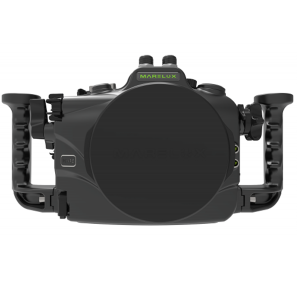
Marelux Canon EOS R5 Underwater Housing
This Marelux Canon EOS R5 underwater housing is built from high-grade aluminum alloy which provides durability and can withstand even the toughest beatings. Ergonomics are also top-notch, all camera controls are readily available at your fingertips and all buttons are clearly labeled. Thanks to its small size, it is great to travel with.
We at the Underwater Photography Guide love the Canon EOS R5 for both underwater photo and video. The R5 is one of the best cameras on the market for underwater photography because of the effective new IBIS system, a crisp 45 megapixel sensor, unique AF tracking capability, quick burst speeds and full autofocus point coverage of the sensor. The top drawbacks of the R5 for underwater photography would be battery life and the plastic-y build of the body. But overall, there are few options on the market that are better for underwater photography - depending on your needs as a photographer.
For underwater video shooters, the Canon EOS R5 offers a whole series of features that would have most underwater video shooters jumping at a chance to shoot the camera - from IBIS that opens up the possibility of good handheld macro video to RAW and C-Log internal recording that allows for the ultimate flexibility in post processing. With the ability to shoot 4K up to frame rates of 120 fps, video shooters will be able to slow down and stabilize the quick scenes from passing schools of fish to sharks on the hunt. 8K video is great if you have an 8K monitor, but even greater if you want to crop your macro video for better compositions. That being said, the drawbacks of recording limits may push serious video shooters to other options like the Sony A7S III.
Either way, you can't go wrong with the Canon EOS R5 - the results speak for themselves.
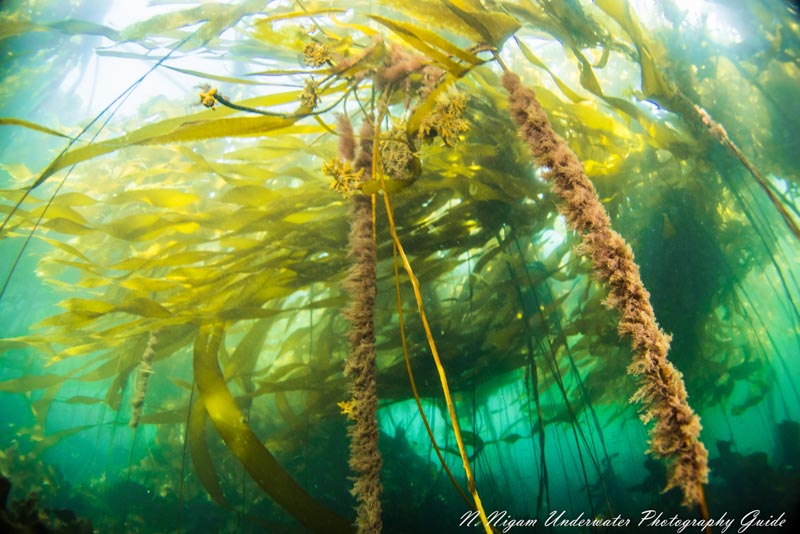
Purchase a Canon EOS R5 underwater housing at Bluewater Photo:
Ikelite Canon EOS R5 Underwater Housing
Sea & Sea Canon EOS R5 Underwater Housing
Aquatica Canon EOS R5 Underwater Housing
Isotta Canon EOS R5 Underwater Housing
Nauticam Canon EOS R5 Underwater Housing
Marelux Canon EOS R5 Underwater Housing
More Canon EOS R5 Content:
Top Canon EOS R5 Underwater Settings
Does the Canon EOS R5 Overheat Underwater?
RECOMMENDED ARTICLES
SUPPORT THE UNDERWATER PHOTOGRAPHY GUIDE:
The Best Service & Prices on u/w Photo Gear
 Visit Bluewater Photo & Video for all your underwater photography and video gear. Click, or call the team at (310) 633-5052 for expert advice!
Visit Bluewater Photo & Video for all your underwater photography and video gear. Click, or call the team at (310) 633-5052 for expert advice!
The Best Pricing, Service & Expert Advice to Book your Dive Trips
 Bluewater Travel is your full-service scuba travel agency. Let our expert advisers plan and book your next dive vacation. Run by divers, for divers.
Bluewater Travel is your full-service scuba travel agency. Let our expert advisers plan and book your next dive vacation. Run by divers, for divers.




